Laboratory Quantification of the Relative Contribution of Staghorn Coral Skeletons to the Total Wave-Energy Dissipation Provided by an Artificial Coral Reef
Abstract
:1. Introduction
2. Materials and Methods
3. Results
4. Discussion
5. Conclusions
Author Contributions
Funding
Institutional Review Board Statement
Informed Consent Statement
Data Availability Statement
Acknowledgments
Conflicts of Interest
Appendix A
Appendix B

References
- Rappaport, J.; Jeffrey, D.S. The United States as a Coastal Nation. J. Econ. Growth 2003, 8, 5–46. [Google Scholar] [CrossRef]
- United Nations. Factsheet: People and Oceans (2017). Available online: https://www.un.org/sustainabledevelopment/wp-content/uploads/2017/05/Ocean-fact-sheet-package.pdf (accessed on 1 August 2021).
- Ghadimi, P.; Lamouki, M.B.P. Finite difference simulation of regular wave propagation over natural beach and composite barriers by Nwogu’s extended Boussinesq equations. Prog. Comput. Fluid Dyn. Int. J. 2017, 17, 212–220. [Google Scholar] [CrossRef]
- Spalding, M.D.; McIvor, A.L.; Beck, M.W.; Koch, E.W.; Möller, I.; Reed, D.J.; Rubinoff, P.; Spencer, T.; Tolhurst, T.J.; Wamsley, T.V.; et al. Coastal Ecosystems: A Critical Element of Risk Reduction. Conserv Lett. 2014, 7, 293–301. [Google Scholar] [CrossRef]
- Guannel, G.; Arkema, K.; Ruggiero, P.; Verutes, G. The Power of Three: Coral Reefs, Seagrasses and Mangroves Protect Coastal Regions and Increase Their Resilience. PLoS ONE 2016, 11, e0158094. [Google Scholar] [CrossRef] [PubMed] [Green Version]
- Reguero, B.G.; Beck, M.W.; Schmid, D.; Stadtmüller, D.; Raepple, J.; Schüssele, S.; Pfliegnerg, K. Financing coastal resilience by combining nature-based risk reduction with insurance. Ecol. Econ. 2020, 169, 106487. [Google Scholar] [CrossRef]
- Van Zanten, B.T.; Van Beukering, P.J.H.; Wagtendonk, A.J. Coastal protection by coral reefs: A framework for spatial assessment and economic valuation. Ocean Coast. Manag. 2014, 96, 94–103. [Google Scholar] [CrossRef]
- Elliff, C.I.; Silva, I.R. Coral reefs as the first line of defense: Shoreline protection in face of climate change. Mar. Environ. Res. 2017, 127, 148–154. [Google Scholar] [CrossRef]
- Chou, L.M.; Huang, D. Towards Coral Reef Resilience. J. Mar. Sci. Eng. 2020, 8, 563. [Google Scholar] [CrossRef]
- Rinkevich, B. Climate change and active reef restoration—Ways of constructing the “reefs of tomorrow”. J. Mar. Sci. Eng. 2015, 3, 111–127. [Google Scholar] [CrossRef]
- Ferrario, F.; Beck, M.W.; Storlazzi, C.D.; Micheli, F.; Shepard, C.C.; Airoldi, L. The effectiveness of coral reefs for coastal hazard risk reduction and adaptation. Nat. Commun. 2014, 5, 3794. [Google Scholar] [CrossRef]
- Gourlay, M.R. Wave set-up on coral reefs. 1. Set-up and wave-generated flow on an idealised two dimensional horizontal reef. Coast. Eng. 1996, 27, 161–193. [Google Scholar] [CrossRef]
- Gourlay, M.R. Wave set-up on coral reefs. 2. Set-up on reefs with various profiles. Coast. Eng. 1996, 28, 17–55. [Google Scholar] [CrossRef]
- Lugo-Fernández, A.; Roberts, H.H.; Suhayda, J.N. Wave transformations across a caribbean fringing-barrier Coral Reef. Cont. Shelf Res. 1998, 18, 1099–1124. [Google Scholar] [CrossRef]
- Vetter, O.; Becker, J.M.; Merrifield, M.A.; Pequignet, A.C.; Aucan, J.; Boc, S.J.; Pollock, C.E. Wave setup over a Pacific Island fringing reef. J. Geophys. Res. Oceans 2010, 115. [Google Scholar] [CrossRef] [Green Version]
- Quataert, E.; Storlazzi, C.; van Rooijen, A.; Cheriton, O.; van Dongeren, A. The influence of coral reefs and climate change on wave-driven flooding of tropical coastlines. Geophys. Res. Lett. 2015, 42, 6407–6415. [Google Scholar] [CrossRef]
- Costa, M.B.S.F.; Araújo, M.; Araújo, T.C.M.; Siegle, E. Influence of reef geometry on wave attenuation on a Brazilian coral reef. Geomorphology 2016, 253, 318–327. [Google Scholar] [CrossRef]
- Symonds, G.; Black, K.P.; Young, I.R. Wave-driven flow over shallow reefs. J. Geophys. Res. Oceans 1995, 100, 2639–2648. [Google Scholar] [CrossRef]
- Nelson, R.C. Hydraulic roughness of coral reef platforms. Appl. Ocean Res. 1996, 18, 265–274. [Google Scholar] [CrossRef]
- De Lalouvière, C.H.; Gracia, V.; Sierra, J.P.; Lin-Ye, J.; García-León, M. Impact of Climate Change on Nearshore Waves at a Beach Protected by a Barrier Reef. Water 2020, 12, 1681. [Google Scholar] [CrossRef]
- Buckley, M.L.; Lowe, R.; Hansen, J.E. Evaluation of nearshore wave models in steep reef environments. Ocean. Dyn. 2014, 64, 847–862. [Google Scholar] [CrossRef]
- Monismith, S.G. Hydrodynamics of Coral Reefs. Annu. Rev. Fluid Mech. 2007, 39, 37–55. [Google Scholar] [CrossRef]
- Risandi, J.; Rijnsdorp, D.P.; Hansen, J.E.; Lowe, R.J. Hydrodynamic modeling of a reef-fringed pocket beach using a phase-resolved non-hydrostatic model. J. Marine Sci. Eng. 2020, 8, 877. [Google Scholar] [CrossRef]
- Storlazzi, C.D.; Reguero, B.G.; Cole, A.D.; Lowe, E.; Shope, J.B.; Gibbs, A.E.; Nickel, B.A.; McCall, R.T.; van Dongeren, A.R.; Beck, M.W. Rigorously Valuing the Role of U.S. Coral Reefs in Coastal Hazard Risk Reduction; Open-File Report 2019–1027; U.S. Geological Survey: Reston, VA, USA, 2019; p. 42. [Google Scholar] [CrossRef] [Green Version]
- Lowe, R.J.; Koseff, J.R.; Monismith, S.G.; Falter, J.L. Oscillatory flow through submerged canopies: 2. Canopy mass transfer. J. Geophys. Res. Oceans 2005, 110. [Google Scholar] [CrossRef] [Green Version]
- Monismith, S.G.; Herdman, L.M.; Ahmerkamp, S.; Hench, J.L. Wave transformation and wave-driven flow across a steep coral reef. J. Phys. Oceanogr. 2013, 43, 1356–1379. [Google Scholar] [CrossRef] [Green Version]
- Ghiasian, M.; Carrick, J.; Rhode-Barbarigos, L.; Haus, B.; Baker, A.C.; Lirman, D. Dissipation of wave energy by a hybrid artificial reef in a wave simulator: Implications for coastal resilience and shoreline protection. Limnol. Oceanogr. Methods 2020. [Google Scholar] [CrossRef]
- Veron, J.E.N. Scleractinia of eastern Australia, Part I, Family Thamnasteriidae, Astrocoeniidae, Pocilloporidae. Aust. Inst. Mar. Sci. Monogr. Ser. 1976, 1, 86. [Google Scholar]
- Bottjer, D.J. Branching morphology of the reef coral Acropora cervicornis in different hydraulic regimes. J. Paleontol. 1980, 1102–1107. [Google Scholar]
- Vargas-Ángel, B.; Thomas, J.D.; Hoke, S.M. High-latitude Acropora cervicornis thickets off Fort Lauderdale, Florida, USA. Coral Reefs 2003, 22, 465–473. [Google Scholar] [CrossRef]
- Goda, Y.; Suzuki, Y. Estimation of Incident and Reflected Waves in Random Wave Experiments. In Coastal Engineering 1976; American Society of Civil Engineers: New York, NY, USA, 1977; pp. 828–845. [Google Scholar] [CrossRef] [Green Version]
- Bogucki, D.J.; Haus, B.K.; Barzegar, M.; Shao, M.; Domaradzki, J.A. On the Nature of the Turbulent Energy Dissipation Beneath Nonbreaking Waves. Geophys. Res. Lett. 2020, 47, e2020GL090138. [Google Scholar] [CrossRef]
- Bogucki, D.; Haus, B.K.; Shao, M. The dissipation of energy beneath non-breaking waves. In Proceedings of the Ocean Sciences Meeting, San Diego, CA, USA, 16–21 February 2020. [Google Scholar]
- NOAA National Data Buoy Center-Station 42095. Available online: https://www.ndbc.noaa.gov/ (accessed on 1 August 2021).
- Airy, G.B. Tides and waves. In Encyclopedia Metropolitana; Biddington: London, UK, 1845. [Google Scholar]
- Gourlay, M.R.; Colleter, G. Wave-generated flow on coral reefs—An analysis for two-dimensional horizontal reef-tops with steep faces. Coast. Eng. 2005, 52, 353–387. [Google Scholar] [CrossRef]
- Kamphuis, J.W. Introduction to Coastal Engineering and Management; World Scientific: Singapore, 2000. [Google Scholar]
- Sheppard, C.; Dixon, D.J.; Gourlay, M.; Sheppard, A.; Payet, R. Coral mortality increases wave energy reaching shores protected by reef flats: Examples from the Seychelles. Estuar. Coast. Shelf Sci. 2005, 64, 223–234. [Google Scholar] [CrossRef]
- Gerritsen, F. Wave Attenuation and Wave Set-Up on a Coastal Reef. In Coastal Engineering 1980; American Society of Civil Engineers: New York, NY, USA, 1980; pp. 444–461. [Google Scholar] [CrossRef] [Green Version]
- Nelson, R.C. A simplified function for wave energy dissipation factor over mobile beds. Coast. Eng. 1989, 13, 149–159. [Google Scholar] [CrossRef]
- Dean, R.G.; Dalrymple, R.A. Water Wave Mechanics for Engineers and Scientists, Hilos Tensados; World Scientific: Singapore, 1991. [Google Scholar] [CrossRef]
- Kamphuis, J.W. Friction factor under oscillatory waves. J. Waterw. Harb. Coast. Eng. Div. 1975, 101, 135–144. [Google Scholar] [CrossRef]
- Nelson, R. Height limits in top down and bottom up wave environments. Coast. Eng. 1997, 32, 247–254. [Google Scholar] [CrossRef]
- Monismith, S.G.; Rogers, J.S.; Koweek, D.; Dunbar, R.B. Frictional wave dissipation on a remarkably rough reef. Geophys. Res. Lett. 2015, 42, 4063–4071. [Google Scholar] [CrossRef]
- Beck, M.W.; Losada, I.J.; Menéndez, P.; Reguero, B.G.; Díaz-Simal, P.; Fernández, F. The global flood protection savings provided by coral reefs. Nat. Commun. 2018, 9. [Google Scholar] [CrossRef] [Green Version]
- Jonsson, I.G. Wave boundary layers and friction factors. Coast. Eng. 1967, 127–148. [Google Scholar] [CrossRef]
- Swart, D.H. Offshore Sediment Transport and Equilibrium Beach Profiles; Publ. No. 131; Delft Hydraul. Lab.: Delft, The Netherlands, 1974; p. 244. [Google Scholar]
- Sorensen, R.M. Basic Coastal Engineering, 3rd ed.; Springer: New York, NY, USA, 2006. [Google Scholar]
- Van der Meer, J.W.; Briganti, R.; Zanuttigh, B.; Wang, B. Wave transmission and reflection at low-crested structures: Design formulae, oblique wave attack and spectral change. Coast. Eng. 2005, 52, 915–929. [Google Scholar] [CrossRef]
- Kim, Y.C. Handbook of Coastal and Ocean Engineering; World Scientific: Singapore, 2010. [Google Scholar]
- Thornton, E.B.; Guza, R.T. Transformation of wave height distribution. J. Geophys. Res. Ocean. 1983, 88, 150. [Google Scholar] [CrossRef] [Green Version]
- Brander, R.W.; Kench, P.S.; Hart, D. Spatial and temporal variations in wave characteristics across a reef platform, Warraber Island, Torres Strait, Australia. Mar. Geol. 2004, 207, 169–184. [Google Scholar] [CrossRef]
- Longuet-Higgins, M.S.; Stewart, R. Radiation stresses in water waves; a physical discussion, with applications. Deep. Res. Oceanogr. Abstr. 1964, 11, 529–562. [Google Scholar] [CrossRef]
- Cheriton, O.; Storlazzi, C.D.; Rosenberger, K.J. Observations and estimates of wave-driven water level extremes at the Marshall. J. Geophys. Res. Ocean. 2016, 121, 3121–3140. [Google Scholar] [CrossRef] [Green Version]
- Ketabdari, M.J.; Moghaddasi, A. Effects of discontinuous submerged breakwater on water surface elevation. Ocean Syst. Eng. 2015, 5, 319–329. [Google Scholar] [CrossRef] [Green Version]
- Barzegar, M.; Palaniappan, D. Numerical study on the performance of semicircular and rectangular submerged breakwaters. Ocean Syst. Eng. 2020, 10, 201–226. [Google Scholar]

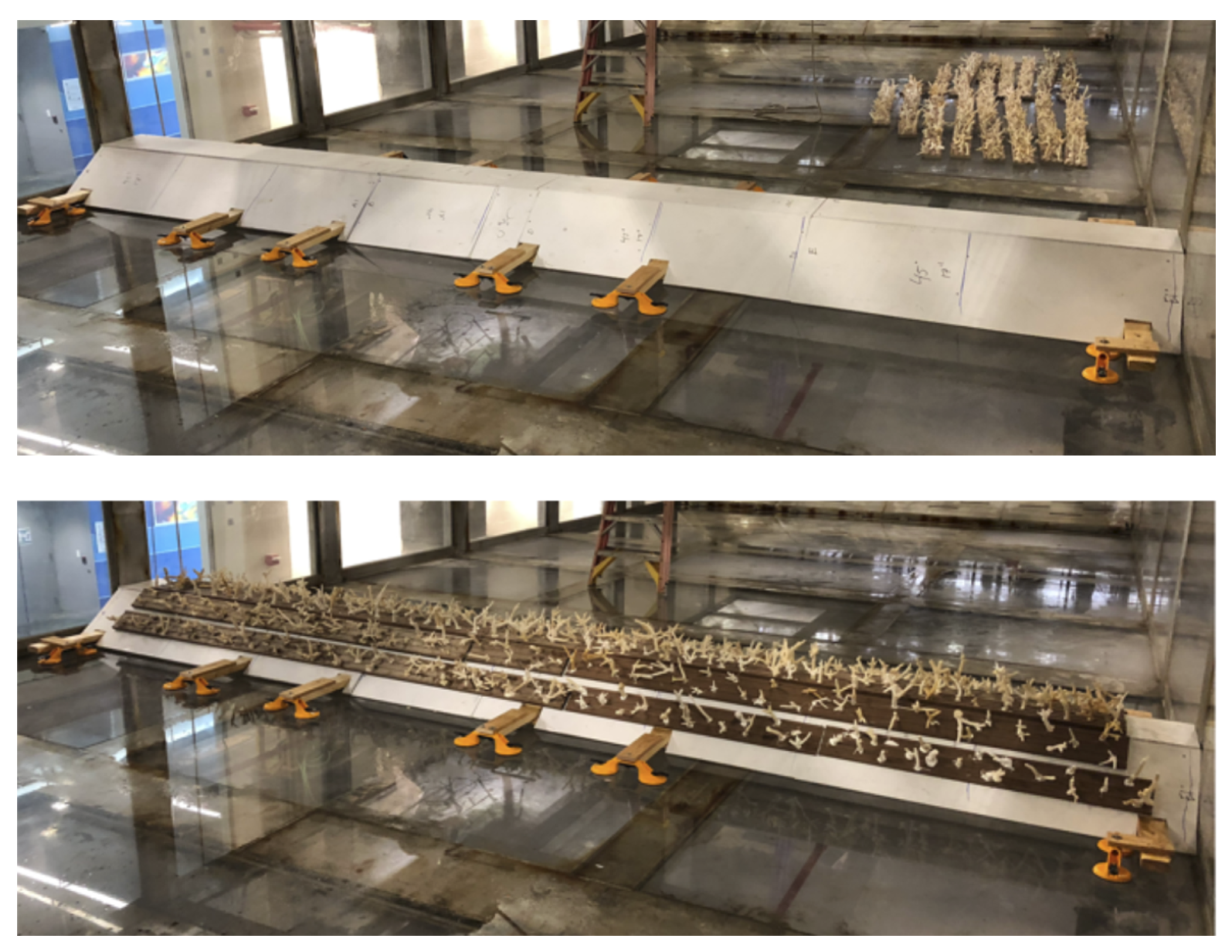

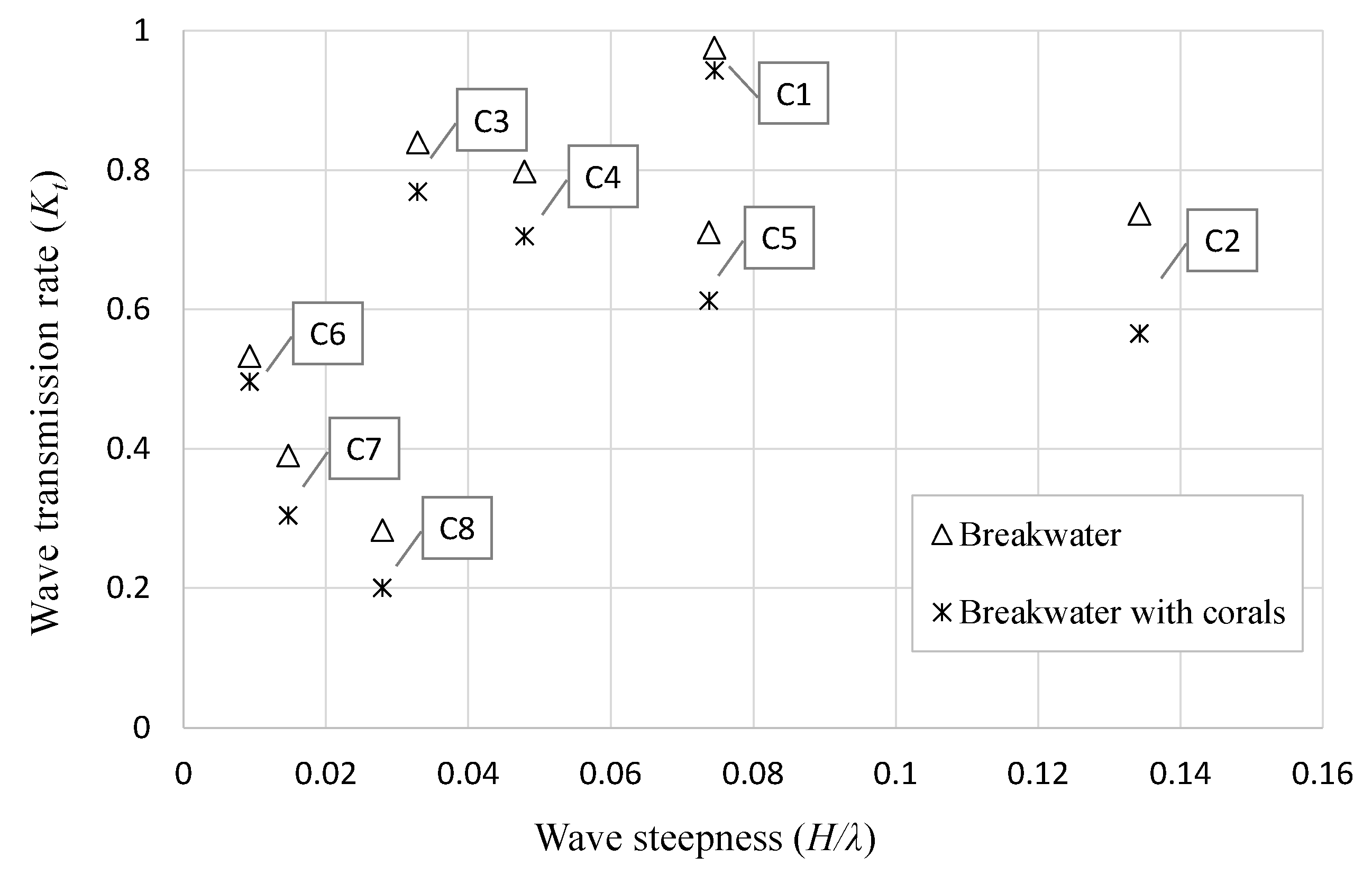
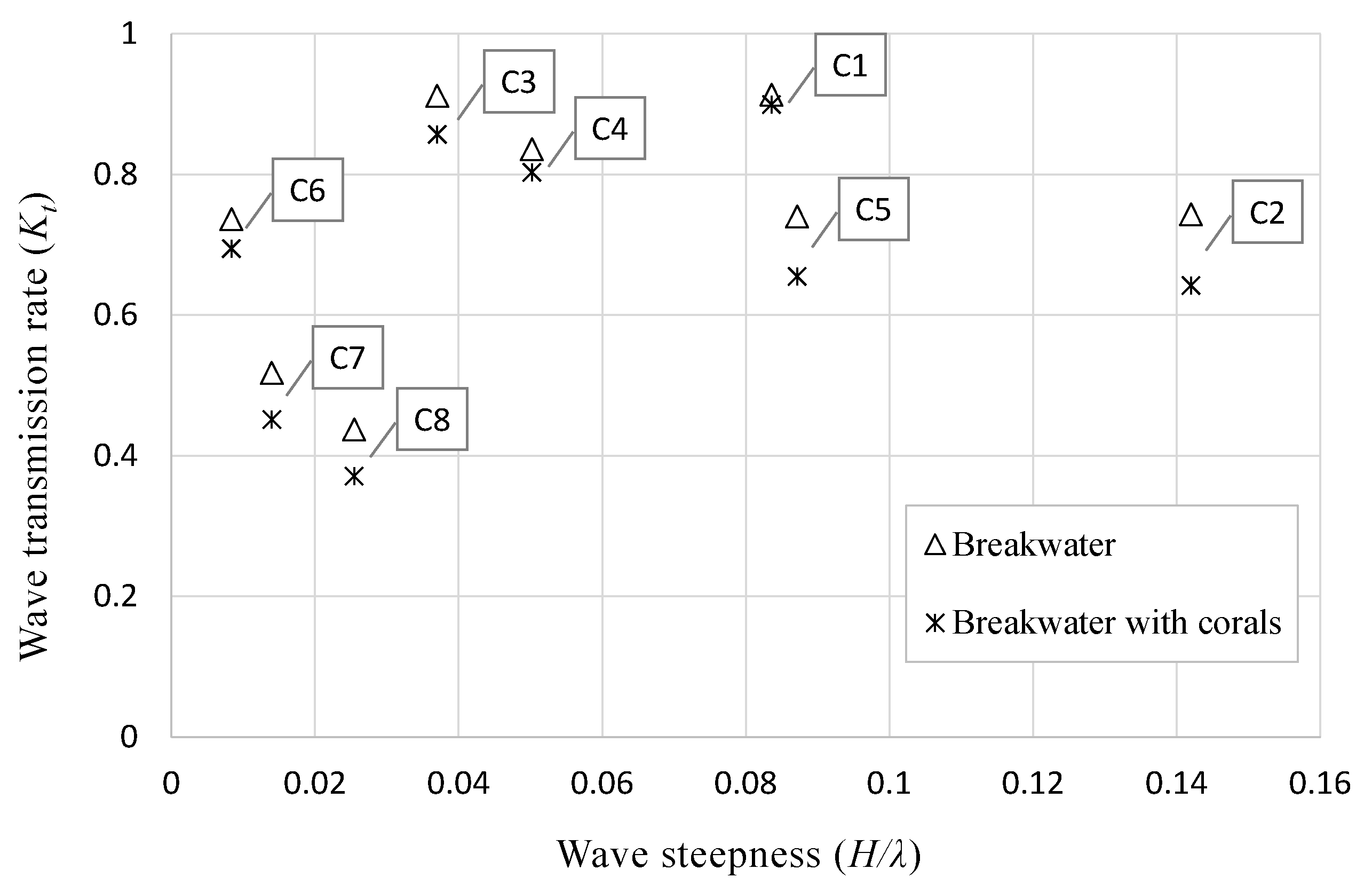

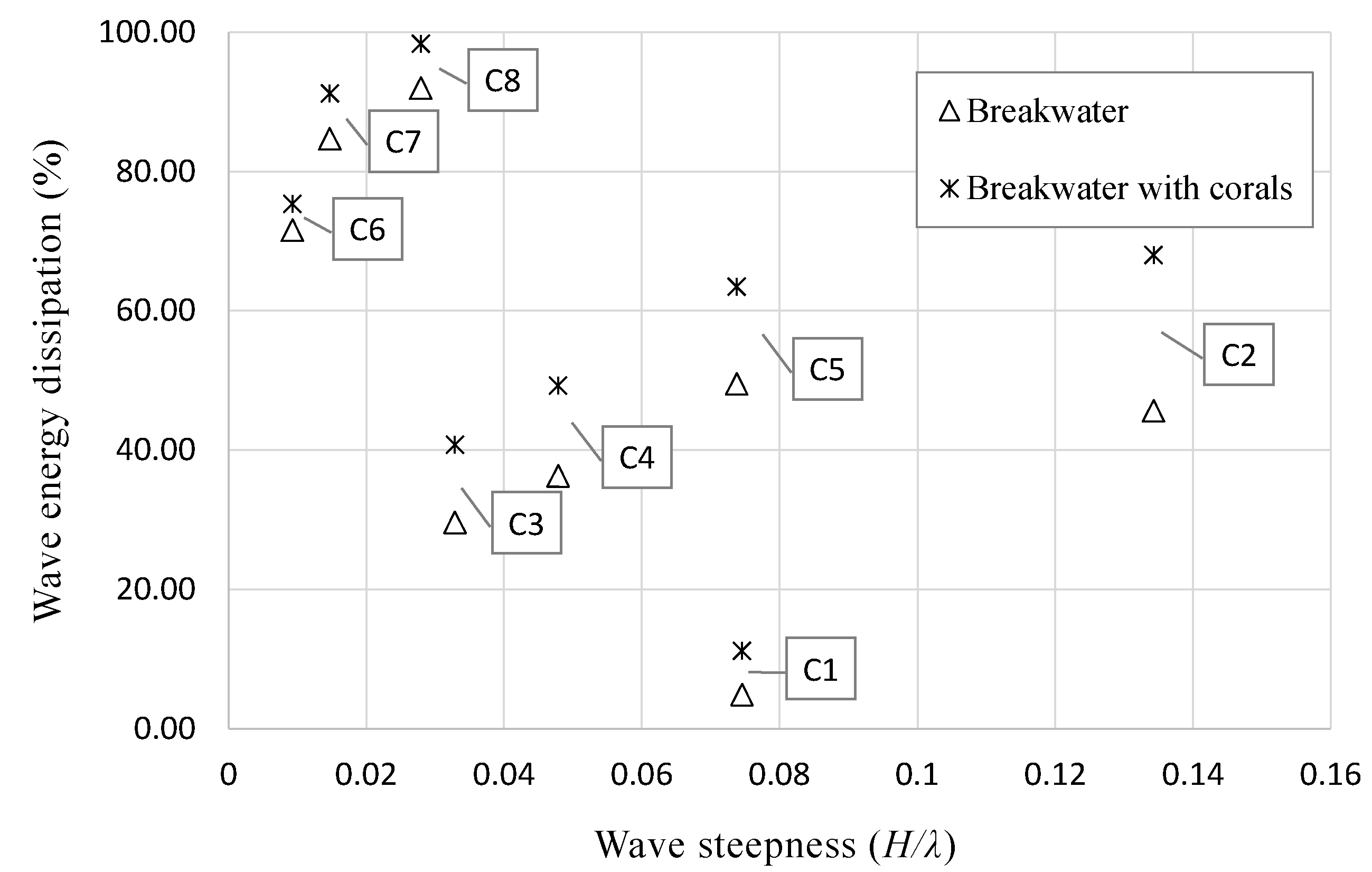
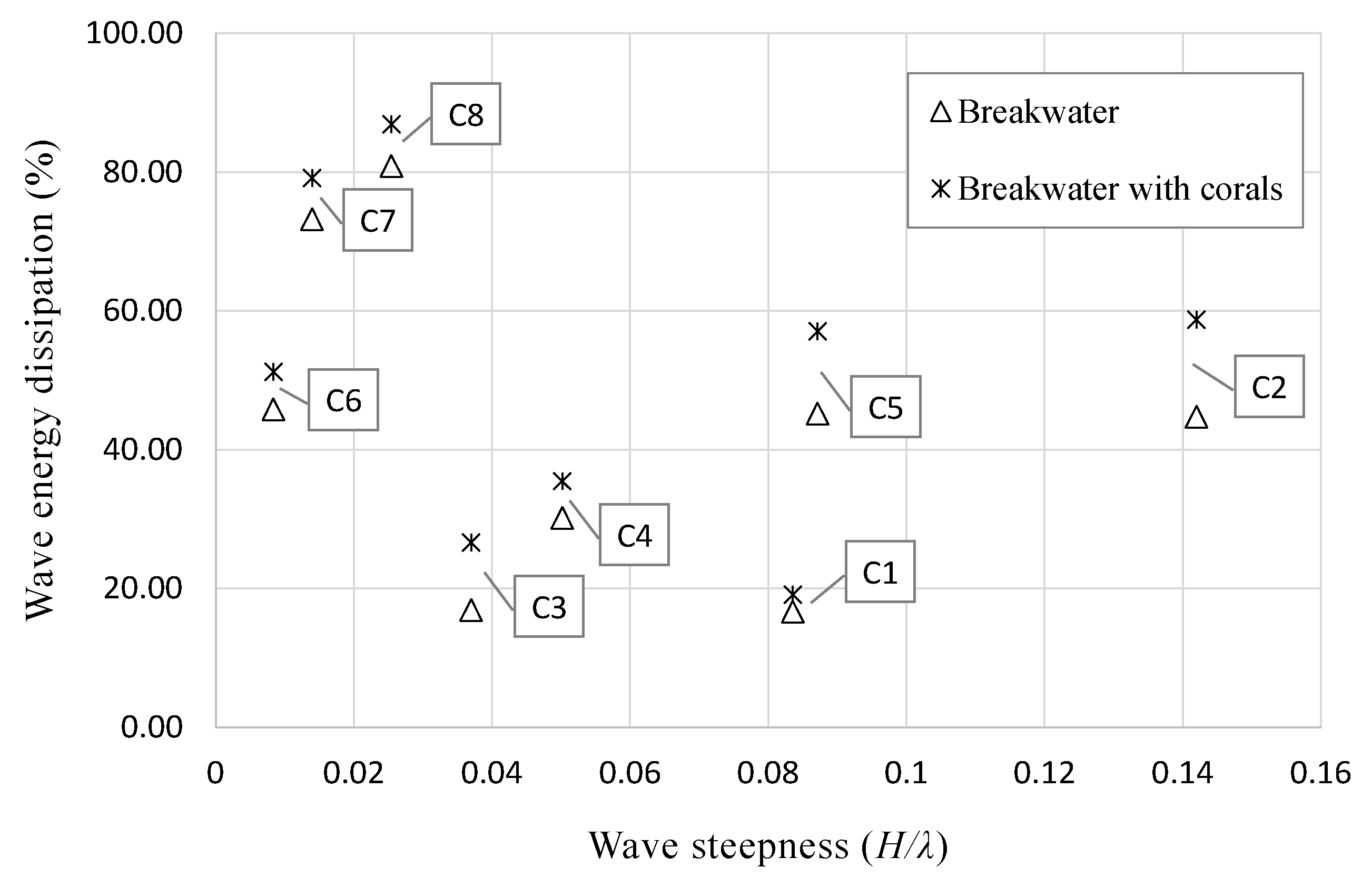
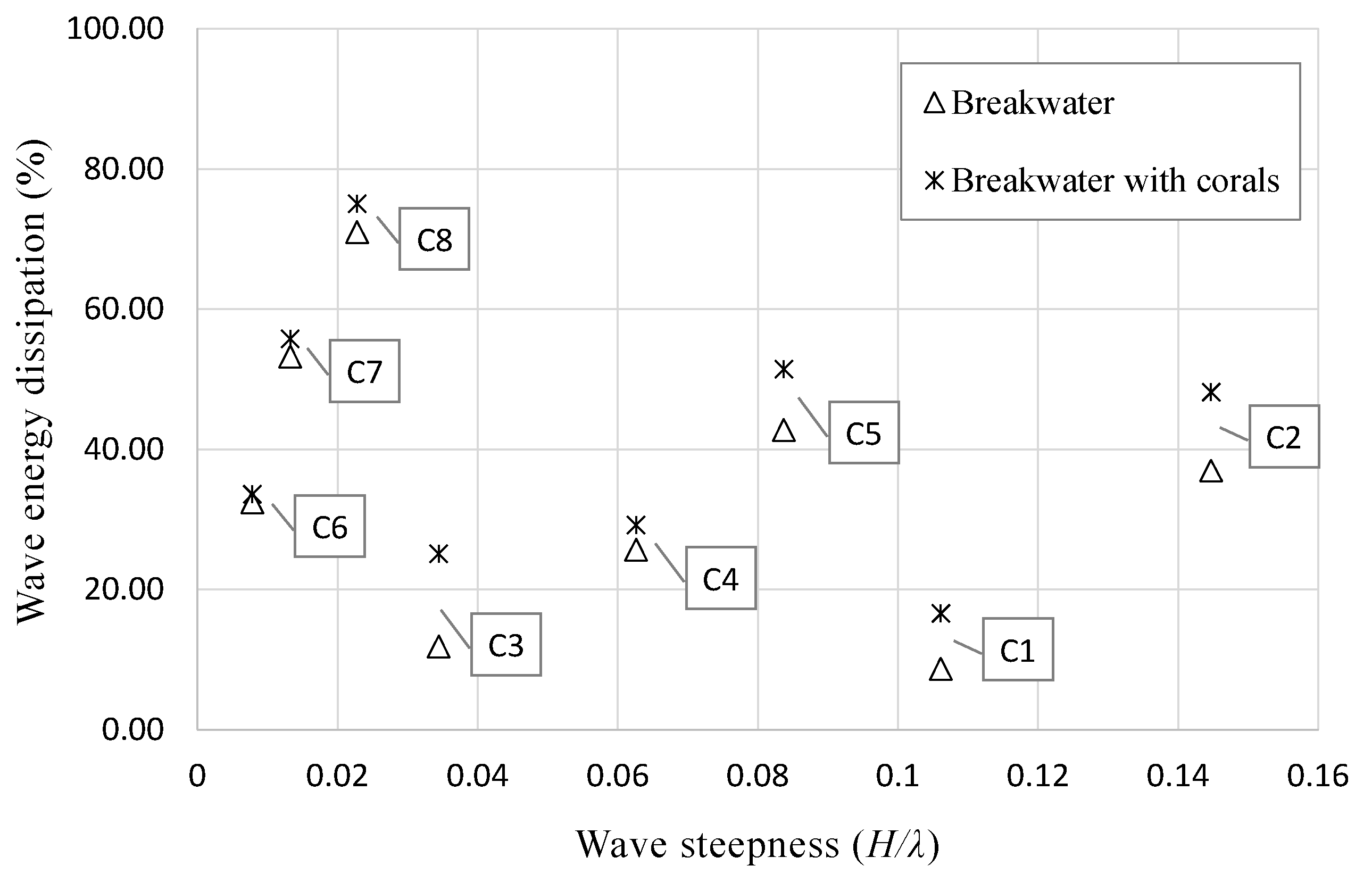

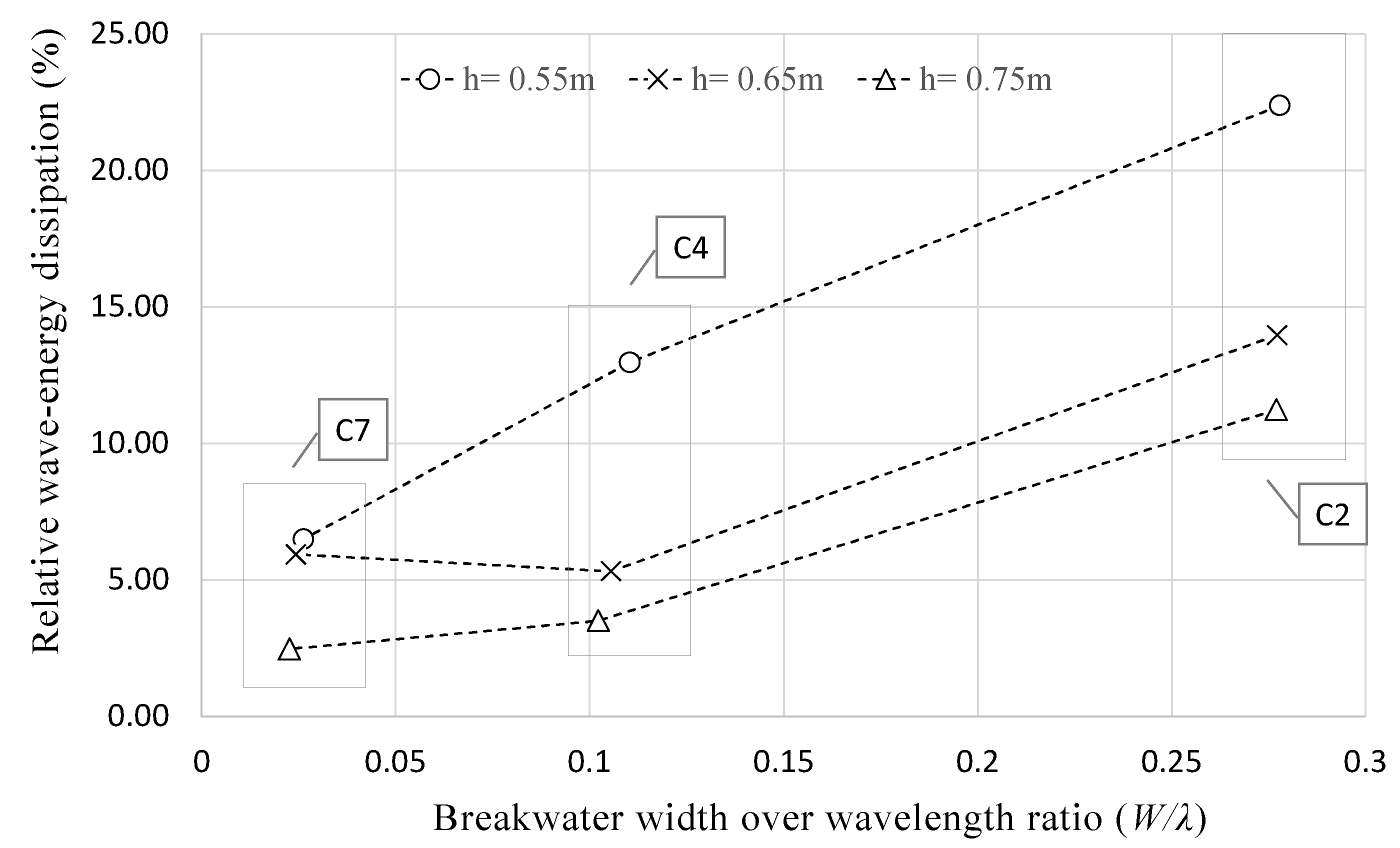
| Parameter | Value | |
|---|---|---|
| Min | Max | |
| Water depth, (m) | 2.00 | 8.00 |
| Dominant wave period, (sec) | 3.90 | 6.40 |
| Significant wave height, (m) | 0.72 | 2.40 |
| Co. # | h (m) | T (s) | H (m) | λ (m) | h/λ (-) | H/λ (-) | Fr (-) | Re (-) |
|---|---|---|---|---|---|---|---|---|
| A | 2.00 | 3.90 | 0.72 | 15.74 | 0.127 | 0.046 | 0.172 | 299,000 |
| B | 2.00 | 3.90 | 1.56 | 15.74 | 0.127 | 0.099 | 0.374 | 3,321,000 |
| C | 2.00 | 6.40 | 0.72 | 27.41 | 0.073 | 0.026 | 0.177 | 634,000 |
| D | 2.00 | 6.40 | 1.56 | 27.41 | 0.073 | 0.057 | 0.383 | 7,049,000 |
| E | 8.00 | 3.90 | 0.72 | 23.14 | 0.346 | 0.031 | 0.041 | 12,000 |
| F | 8.00 | 3.90 | 2.40 | 23.14 | 0.346 | 0.104 | 0.137 | 139,000 |
| G | 8.00 | 6.40 | 0.72 | 49.25 | 0.162 | 0.015 | 0.042 | 98,000 |
| H | 8.00 | 6.40 | 2.40 | 49.25 | 0.162 | 0.049 | 0.141 | 1,089,000 |
| Parameter | Values |
|---|---|
| Wave period T (s) | [0.83; 1.42; 5.00] |
| Regular wave height H (m) | [0.10; 0.20; 0.30] |
| Water depth h (m) | [0.55; 0.65; 0.75] |
| Co. # | T (s) | H (m) | H/λ (-) | Fr (-) | Re (-) | ||||
|---|---|---|---|---|---|---|---|---|---|
| h = 0.55 m | h = 0.65 m | h = 0.75 m | h = 0.55 m | h = 0.65 m | h = 0.75 m | ||||
| C1 | 0.83 | 0.10 | 0.093 | 0.146 | 0.115 | 0.097 | 1390 | 550 | 280 |
| C2 | 0.83 | 0.16 | 0.148 | 0.234 | 0.184 | 0.156 | 4510 | 1580 | 510 |
| C3 | 1.42 | 0.10 | 0.037 | 0.139 | 0.104 | 0.083 | 6620 | 5990 | 3690 |
| C4 | 1.42 | 0.16 | 0.059 | 0.223 | 0.166 | 0.133 | 14,040 | 11,000 | 12,180 |
| C5 | 1.42 | 0.24 | 0.088 | 0.335 | 0.249 | 0.200 | 33,370 | 33,190 | 21,770 |
| C6 | 5.00 | 0.10 | 0.009 | 0.149 | 0.112 | 0.090 | 43,670 | 34,930 | 29,900 |
| C7 | 5.00 | 0.16 | 0.014 | 0.239 | 0.179 | 0.144 | 110,090 | 97,570 | 85,970 |
| C8 | 5.00 | 0.30 | 0.026 | 0.448 | 0.336 | 0.271 | 396,420 | 322,360 | 253,080 |
| Co. # | Relative Contribution of the Corals in the Total Wave-Energy Dissipation [%] | ||
|---|---|---|---|
| h = 0.55 m | h = 0.65 m | h = 0.75 m | |
| C1 | 56.3 | 13.0 | 47.7 |
| C2 | 32.9 | 23.8 | 23.3 |
| C3 | 27.6 | 36.6 | 52.8 |
| C4 | 26.3 | 15.0 | 12.0 |
| C5 | 22.0 | 20.7 | 16.8 |
| C6 | 5.0 | 10.5 | 3.2 |
| C7 | 7.1 | 7.5 | 4.4 |
| C8 | 6.5 | 6.9 | 5.3 |
Publisher’s Note: MDPI stays neutral with regard to jurisdictional claims in published maps and institutional affiliations. |
© 2021 by the authors. Licensee MDPI, Basel, Switzerland. This article is an open access article distributed under the terms and conditions of the Creative Commons Attribution (CC BY) license (https://creativecommons.org/licenses/by/4.0/).
Share and Cite
Ghiasian, M.; Carrick, J.; Bisson, C.; Haus, B.K.; Baker, A.C.; Lirman, D.; Rhode-Barbarigos, L. Laboratory Quantification of the Relative Contribution of Staghorn Coral Skeletons to the Total Wave-Energy Dissipation Provided by an Artificial Coral Reef. J. Mar. Sci. Eng. 2021, 9, 1007. https://doi.org/10.3390/jmse9091007
Ghiasian M, Carrick J, Bisson C, Haus BK, Baker AC, Lirman D, Rhode-Barbarigos L. Laboratory Quantification of the Relative Contribution of Staghorn Coral Skeletons to the Total Wave-Energy Dissipation Provided by an Artificial Coral Reef. Journal of Marine Science and Engineering. 2021; 9(9):1007. https://doi.org/10.3390/jmse9091007
Chicago/Turabian StyleGhiasian, Mohammad, Jane Carrick, Claire Bisson, Brian K. Haus, Andrew C. Baker, Diego Lirman, and Landolf Rhode-Barbarigos. 2021. "Laboratory Quantification of the Relative Contribution of Staghorn Coral Skeletons to the Total Wave-Energy Dissipation Provided by an Artificial Coral Reef" Journal of Marine Science and Engineering 9, no. 9: 1007. https://doi.org/10.3390/jmse9091007
APA StyleGhiasian, M., Carrick, J., Bisson, C., Haus, B. K., Baker, A. C., Lirman, D., & Rhode-Barbarigos, L. (2021). Laboratory Quantification of the Relative Contribution of Staghorn Coral Skeletons to the Total Wave-Energy Dissipation Provided by an Artificial Coral Reef. Journal of Marine Science and Engineering, 9(9), 1007. https://doi.org/10.3390/jmse9091007






